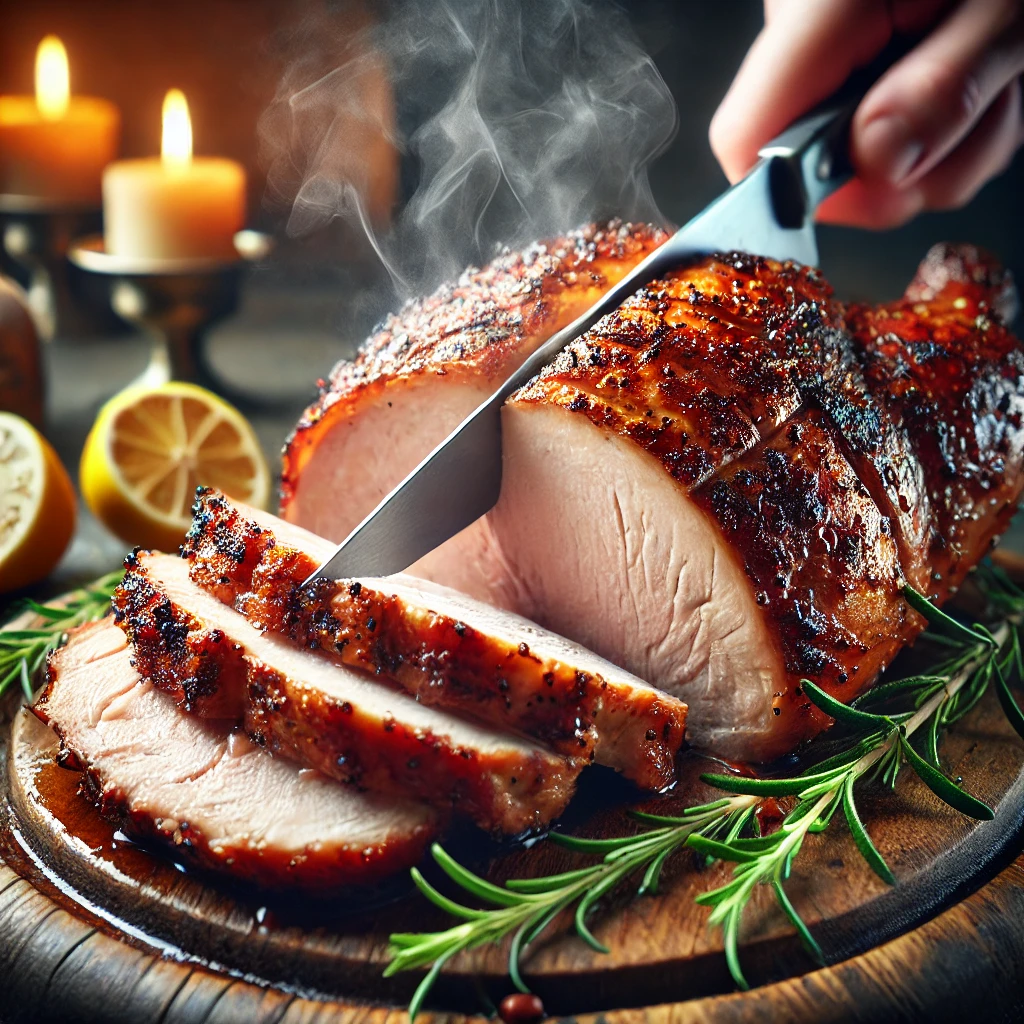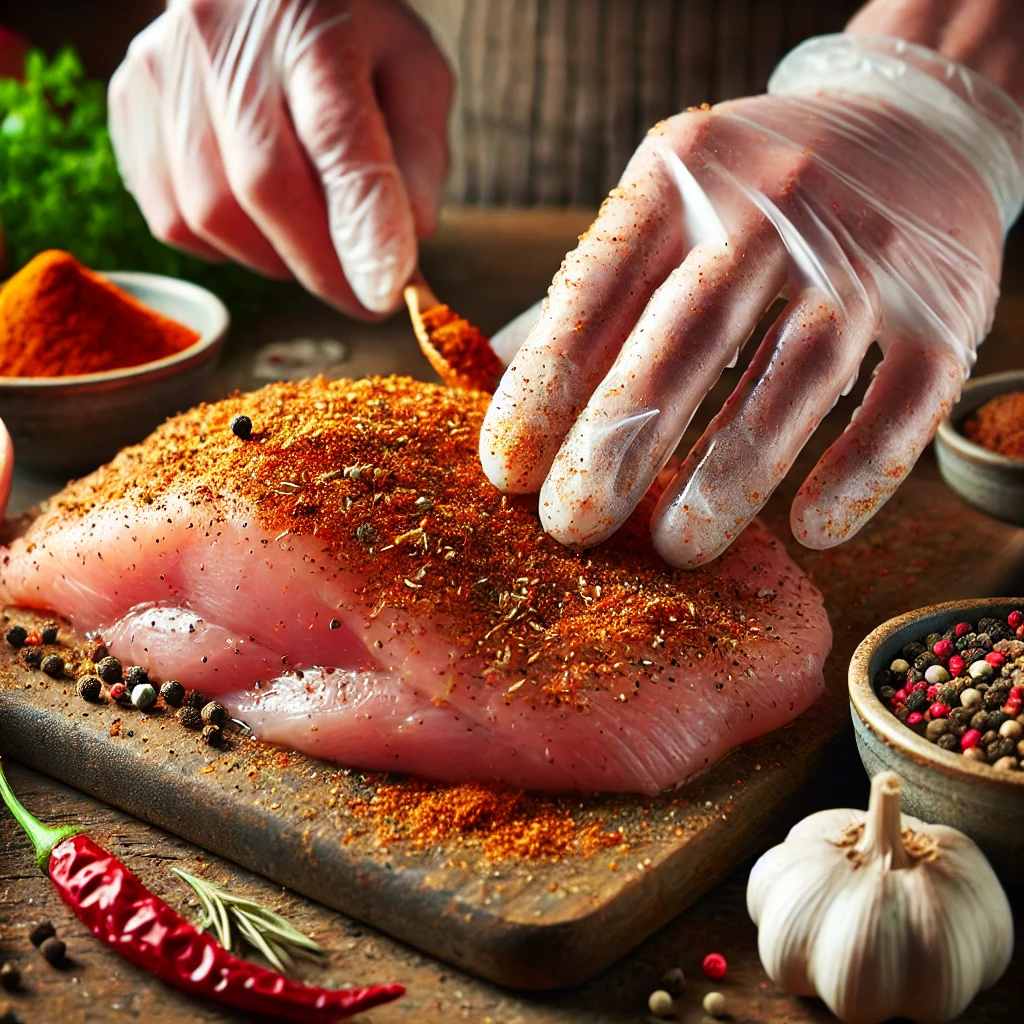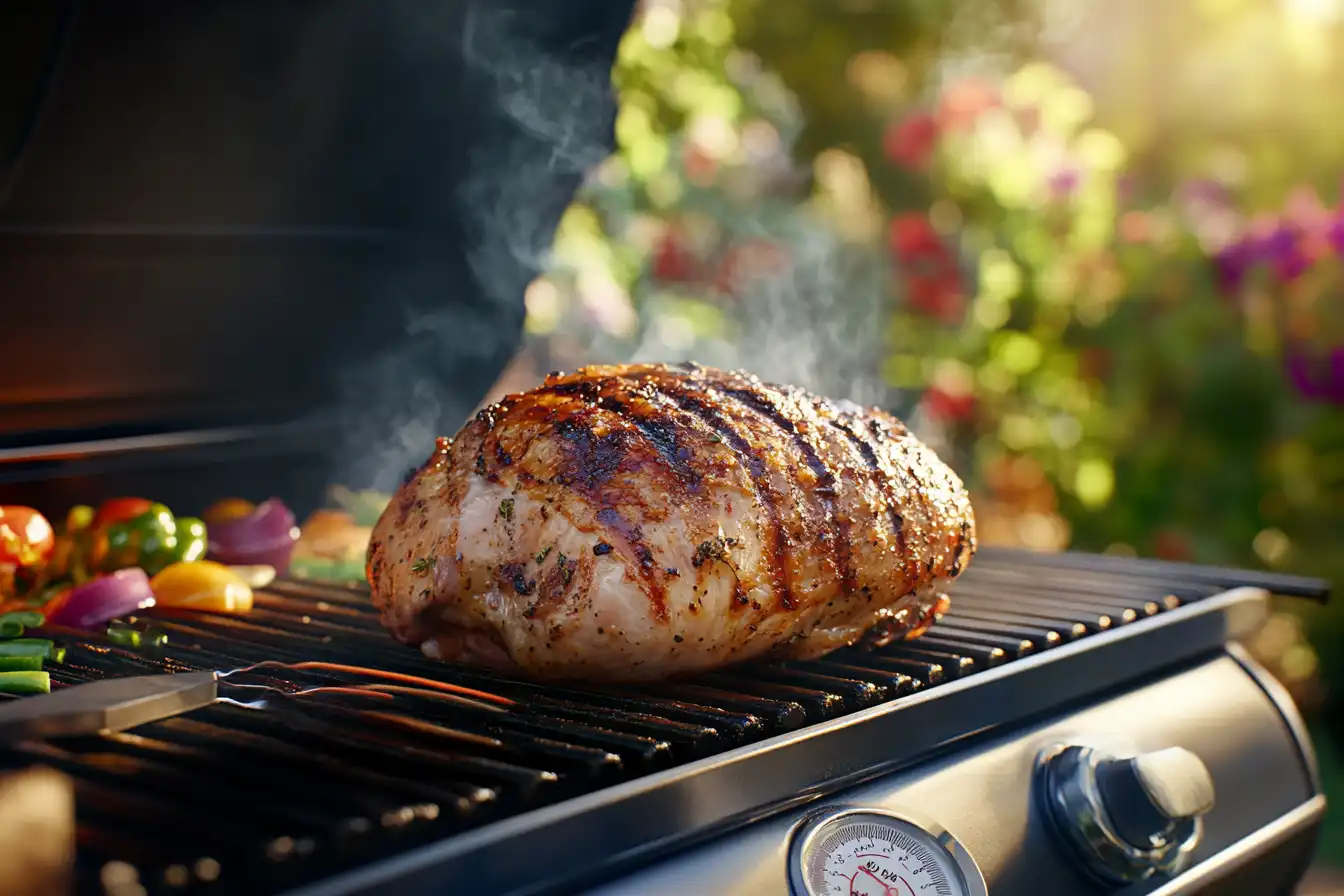Introduction
When it comes to creating a meal that’s both flavorful and nutritious, grilled turkey breast is an undeniable winner. It’s versatile, lean, and works well with a variety of marinades and rubs, making it a favorite for backyard barbecues and weeknight dinners alike. This guide will take you step by step through everything you need to know, from picking the perfect cut to mastering the grill and serving up juicy, tender turkey that’s sure to impress. Let’s get started with the essentials!
Part 1: Selecting the Perfect Turkey Breast for Grilling
Fresh vs. Frozen Turkey Breast
Choosing between fresh and frozen turkey breast is like deciding between convenience and immediate flavor. Fresh turkey, often found at local butchers or specialty markets, is naturally moist and brimming with flavor, making it an ideal choice when time permits. However, it requires careful handling since it has a shorter shelf life and must be cooked within a few days of purchase.
Frozen turkey breasts, on the other hand, offer a longer storage window and are widely available. The key is proper thawing—rushing the process can leave unevenly thawed sections, leading to disappointing results on the grill. Thaw it slowly in the refrigerator for optimal texture and flavor. Either way, the choice comes down to your timeline and priorities.
Bone-In vs. Boneless Turkey Breast
The decision between bone-in and boneless turkey breast boils down to cooking style and personal preference. Bone-in turkey breasts often pack a punch when it comes to juiciness. The bone helps retain heat, keeping the meat tender and moist while also adding a subtle depth of flavor. But there’s a catch—it takes longer to cook and may require more attention to ensure even grilling.
Boneless turkey breasts, on the flip side, are simpler to handle and cook faster, making them perfect for beginners or those on a tight schedule. Plus, they’re easier to slice for serving. Whichever you choose, pairing it with the right marinade or rub can elevate the flavor to new heights.
For tips on selecting the best cut for grilling, check out Grilling Tips for Beginners, which offers valuable insights into handling meat like a pro.
Part 2: Preparation and Seasoning
Preparing Your Turkey Breast for the Grill
Thawing and Cleaning
Proper thawing and cleaning are the first steps to a safe and successful grilling experience. If you’re starting with a frozen turkey breast, plan ahead! Thaw it in the refrigerator—never at room temperature—to avoid uneven defrosting and bacterial growth. Allow 24 hours for every 4–5 pounds of turkey.
Once thawed, rinse the turkey breast under cool running water to remove any residue or ice crystals, and then pat it dry with paper towels. Removing excess moisture is crucial to ensure the seasonings stick and the skin crisps up nicely during grilling. Always clean your workspace and utensils thoroughly to prevent cross-contamination.
Brining: Techniques and Benefits
Brining is a game-changer for grilled turkey breast. This method infuses moisture and enhances flavor, ensuring your turkey is juicy and delicious. A basic brine solution includes water, salt, and sugar, but feel free to add herbs, garlic, or citrus for extra depth.
Submerge the turkey breast in the brine and refrigerate for 8–12 hours. For a quicker alternative, opt for a dry brine by rubbing salt and spices directly onto the turkey breast. This approach draws moisture to the surface, helping to create a crispier skin while locking in flavor. Rinse off the brine before grilling to avoid overly salty results.
Seasoning Options for Grilled Turkey Breast
Dry Rubs: Recipes and Application Methods
Dry rubs are a simple yet effective way to add bold flavors to your grilled turkey breast. Combine pantry staples like paprika, garlic powder, onion powder, and a touch of cayenne for a smoky, slightly spicy rub. For a sweeter profile, incorporate brown sugar and cinnamon.
Apply the rub generously, pressing it into the meat to ensure even coverage. For best results, let the seasoned turkey breast sit for 30 minutes to an hour before grilling, allowing the flavors to penetrate. Pairing a good rub with indirect heat cooking ensures your turkey is both tasty and tender.
Marinades: Flavor Profiles and Marinating Times
Marinades are perfect for enhancing the flavor of your turkey breast while keeping it moist. A marinade typically combines an acid (like lemon juice or vinegar), oil, and seasonings. For a Mediterranean vibe, mix olive oil, garlic, oregano, and lemon. Prefer something spicy? Try a chipotle-lime marinade for a kick of heat.
Immerse the turkey breast in the marinade for at least 2 hours, or overnight for maximum impact. Always marinate in the refrigerator to prevent bacterial growth. Before grilling, pat the turkey dry to remove excess liquid—this prevents steaming and ensures a beautiful char on the grill.
Part 3: Grilling Techniques and Cooking
Grilling Techniques for Turkey Breast

Direct vs. Indirect Grilling
Mastering the choice between direct and indirect grilling is crucial for achieving perfectly cooked turkey breast. Direct grilling, where the meat is placed directly over the heat source, works well for thin cuts or quickly searing the outside. This method helps lock in juices and adds a delightful char to the surface. However, when it comes to turkey breast—especially thick cuts—direct grilling alone can lead to uneven cooking or dryness.
Indirect grilling is the real hero for turkey breast. With this method, the turkey cooks slowly using heat that circulates around it rather than directly below it. This approach is especially effective for thicker, bone-in cuts, allowing them to cook through evenly while retaining moisture. The best technique? Start with direct heat to sear, then shift to indirect heat to finish cooking to perfection.
Achieving the Ideal Grill Temperature
Getting the grill temperature just right is the linchpin of success. Too hot, and you risk charring the outside while leaving the inside undercooked. Too low, and your turkey could dry out from prolonged exposure. Aim for a grill temperature of 350–375°F (medium heat) for indirect cooking. Use a grill thermometer to monitor the heat consistently. If you’re using charcoal, arrange the coals to one side for indirect heat, while for gas grills, only light one or two burners.
Cooking Times and Temperature Guidelines
Using a Meat Thermometer for Accuracy
A meat thermometer is your best ally for grilling turkey breast. Forget guesswork! Insert the thermometer into the thickest part of the breast, ensuring it doesn’t touch bone for accurate readings. Turkey breast should reach an internal temperature of 165°F for safe consumption. Pull it off the grill a few degrees before, as the residual heat will finish the job while resting.
Resting the Meat: Importance and Duration
Once your turkey breast is grilled to perfection, resist the urge to slice into it right away. Resting the meat allows the juices to redistribute, ensuring every bite is tender and flavorful. Cover the turkey loosely with foil and let it rest for 10–15 minutes. Skipping this step can result in a dry dish, no matter how well it was cooked.
Part 4: Enhancing Flavor and Avoiding Pitfalls
Achieving Perfect Grill Marks and Crispy Skin
Oil Application and Grill Maintenance
Creating those envy-worthy grill marks starts with a clean, well-oiled grill. Use a brush to remove debris from the grates, then apply a light coat of oil to prevent sticking. For crispy skin, lightly oil the turkey breast itself before placing it on the grill. This helps achieve an even sear and a golden-brown finish.
Timing and Turning Techniques
Timing is everything when it comes to grilling turkey breast. Avoid flipping it too often, as this can prevent a good sear. Start by grilling the breast skin-side down for 6–8 minutes over direct heat to develop a crust. Then, flip it carefully using tongs and move it to indirect heat. Turning once or twice during cooking ensures even heat distribution.
Common Mistakes to Avoid When Grilling Turkey Breast
Overcooking and Undercooking
Overcooking is the quickest route to a dry turkey breast. Always use a thermometer to avoid this common pitfall. On the flip side, undercooking poses food safety risks. Ensure the thickest part of the turkey breast reaches 165°F, but don’t rush the process by cranking up the heat.
Inadequate Seasoning
A bland turkey breast is a missed opportunity! Season generously with a dry rub or marinade, making sure it penetrates well. Too often, people under-season large cuts like turkey breast, leaving the flavor concentrated on the surface. Marinating or brining beforehand can prevent this mistake and enhance every bite.
Part 5: Serving, Storing, and Health Benefits
Serving Suggestions for Grilled Turkey Breast
Side Dishes That Complement
Pairing the perfect side dishes with your grilled turkey breast can elevate the entire meal. Consider vibrant, nutrient-packed options like roasted vegetables, which balance the smokiness of the turkey. Grilled asparagus, sweet potatoes, or a fresh summer salad with a light vinaigrette work wonders to enhance the dish’s flavors.
For a heartier meal, opt for whole grains like quinoa or wild rice. These earthy options bring texture and nutrition to the table while soaking up the juices from the turkey. A creamy herb sauce or cranberry chutney on the side can provide a tangy kick, adding even more depth to the plate.
Wine and Beverage Pairings
While alcoholic pairings are off-limits, you can enjoy grilled turkey breast with flavorful non-alcoholic beverages. A glass of sparkling apple cider offers a crisp contrast, while iced herbal teas like mint or chamomile complement the meat’s natural richness. For an earthy twist, try serving a smoky lapsang souchong tea, which pairs beautifully with grilled flavors. Even a simple lemonade or cucumber-infused water can provide a refreshing accompaniment.
Storing and Reheating Leftover Grilled Turkey Breast
Refrigeration and Freezing Guidelines
Proper storage ensures that leftover grilled turkey breast stays delicious for days. After cooling the meat to room temperature, place it in an airtight container or wrap it tightly in aluminum foil to lock in moisture. Refrigerate within two hours of cooking, and consume within 3–4 days for the best taste and safety.
For longer storage, freezing is your best bet. Slice the turkey breast into portions for convenience, then store them in freezer-safe bags with as much air removed as possible. Frozen turkey breast can be kept for up to three months. Always label containers with the date for easy tracking.
Reheating Methods to Retain Juiciness
Reheating turkey breast without losing its moisture requires care. The oven is a reliable choice—wrap the meat in foil and heat at 300°F until warmed through. Adding a splash of broth or water can help prevent drying out. For smaller portions, a microwave works, but use a lower power setting and cover the meat to trap steam.
If you’re short on time, a skillet with a bit of oil or butter offers a quick and effective reheating method. Avoid overheating, as this can lead to tough, dry meat. Aim for a gentle, consistent temperature.
Health Benefits of Grilled Turkey Breast
Nutritional Profile
Grilled turkey breast is a lean, protein-rich option that fits into almost any diet. A 3-ounce serving provides about 26 grams of high-quality protein with minimal fat content, making it ideal for muscle building and repair. It’s also packed with essential nutrients like selenium, B vitamins, and zinc, which support immune function and energy production.
Compared to other proteins, turkey breast is naturally lower in calories, making it a smart choice for those aiming to maintain or lose weight. The absence of added oils or heavy coatings during grilling further enhances its health benefits.
Comparing to Other Grilled Meats
When stacked against other grilled meats, turkey breast stands out for its nutritional balance. Unlike fattier cuts of beef or pork, turkey is lower in saturated fats, reducing the risk of heart disease. It’s also easier to digest, making it a great option for those with sensitive stomachs.
Grilled chicken might share similar attributes, but turkey offers a slightly higher iron content, which supports healthy blood circulation. Plus, turkey’s flavor profile is unique—mild yet rich enough to absorb a variety of marinades and seasonings, offering versatility that’s hard to beat.
Part 6: Frequently Asked Questions (FAQs)
How long should I marinate the turkey breast before grilling?
Marinating time depends on the marinade and the size of the turkey breast. For optimal flavor, marinate for at least 2–4 hours. If time permits, marinating overnight (up to 24 hours) ensures deeper flavor penetration, especially for thicker cuts. For quick results, a 30-minute marinade can work in a pinch, but the flavor may not be as pronounced. Always refrigerate the turkey breast while marinating to prevent spoilage and maintain freshness.
What is the ideal internal temperature for grilled turkey breast?
The ideal internal temperature for grilled turkey breast is 165°F (74°C). Use a meat thermometer to check the thickest part of the breast, avoiding bone contact to ensure accuracy. It’s wise to remove the turkey from the grill when it reaches about 160°F, as the residual heat will bring it up to the safe 165°F while resting. This prevents overcooking and preserves juiciness.
Can I grill a frozen turkey breast?
Grilling a frozen turkey breast isn’t recommended because it cooks unevenly, leaving the outer layers overdone while the center remains raw. Instead, thaw the turkey breast thoroughly in the refrigerator. If you’re short on time, you can use the cold water method: submerge the breast in its packaging in cold water, changing the water every 30 minutes until thawed.
How do I prevent the turkey breast from drying out on the grill?
To keep your turkey breast juicy, follow these tips: use a marinade or brine to infuse moisture, cook over indirect heat to avoid overexposure to high temperatures, and don’t overcook—monitor with a meat thermometer. Basting with melted butter or oil during grilling can also help retain moisture, while resting the meat after grilling allows juices to redistribute.
What wood chips are best for smoking turkey breast on the grill?
Mild wood chips like apple, cherry, or pecan are ideal for smoking turkey breast. These woods provide a sweet, subtle flavor that complements the meat without overwhelming it. For a bolder taste, try hickory, but use it sparingly as it can become overpowering. Soak wood chips in water for 30 minutes before use to produce a steady stream of flavorful smoke.
How can I add a smoky flavor without a smoker?
You can add a smoky flavor to your turkey breast using a gas or charcoal grill. Create a foil packet filled with soaked wood chips, then place it on the grill over the heat source. Alternatively, use smoked paprika or liquid smoke in your marinade or rub for a similar effect. These methods mimic the smoky taste of a traditional smoker without extra equipment.
Part 7: Conclusion
Grilling turkey breast is more than just a cooking technique—it’s an opportunity to create a mouthwatering, healthy meal that’s perfect for any occasion. From selecting the best cut to mastering marinades, seasoning, and grilling techniques, this guide has covered all the essentials. With the right preparation, patience, and a touch of creativity, you’ll achieve tender, flavorful results every time.
So why wait? Fire up the grill, experiment with flavors, and enjoy the satisfying experience of serving perfectly grilled turkey breast to your family and friends. It’s easier than you think—and more delicious than you can imagine!



